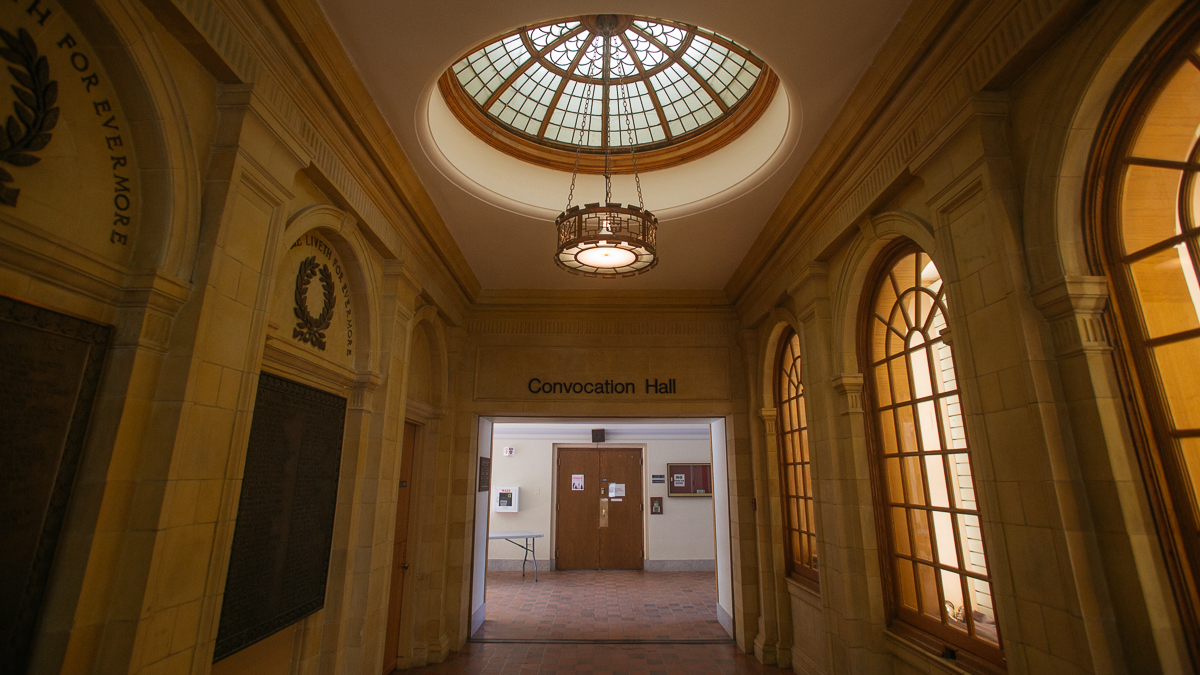Quartetto Gelato is hot and liquid, the opposite of ice cream
 Rosty Soroka
Rosty SorokaClassical and deliberate in training but modern and lively in practice, Quartetto Gelato delivers an exciting performance filled with action and energy, with smiles and laughter all around.
Who: Quartetto Gelato (Peter De Sotto, Colin Maier, Kirk Starkey, Charles Cozens)
What: Kilburn Memorial Concert
When: Thursday, January 17 at 7:30pm
Where: Convocation Hall
Featured in the department of music’s Kilburn Memorial Concert, classical-contemporary fusion group Quartetto Gelato started off the evening with the fast and intriguing “Romamolda Hora,” an Eastern European piece, entrancing the audience with their rapid flutters.
After that fluid performance, the quartet moved across the continent and rolled back the tempo to France, playing “Under Paris Skies” and the classic “La Vie en Rose.” Here was the first time we heard Peter De Sotto’s own voice.
Classically trained, his operatic tenor voice has been compared to that of Pavarotti. His voice was easily overpowered by instruments, but he grew into his spot later in the performance.
But they wouldn’t stay in France for long before moving into Switzerland with “Tango del Mare,” a straightforward classical tango which then set the mood for other, more Latin-inspired music, such as “Meditango,” a tango with a jazz twist from Brazil.
The quartet finished the first half of the concert with “Gypsy Fantasia,” a piece written specifically for them by Canadian composer Jossy Abramovich. It expressed the specific talents of the quartet with a train-like rhythm that kept the audience — as well as the performers — on their toes with frequent tempo and key changes.
However, most interesting in this piece was the prominence of Colin Maier’s oboe. This was a theme that would recur soon in the song “Pipes,” in which Quartetto Gelato performed a traditional Scottish tune wherein Maier’s oboe imitated the sound of bagpipes.
De Sotto boasted to the crowd that Maier would be performing this piece with the help of an advanced breathing technique called circular breathing, where the musician breathes in through their nose and out through their mouth at the same time. This allows the musician to continue playing without wasting any time breathing in the piece, a necessary component in a composition created to emulate the sound of bagpipes. This was an interesting and novel use of the technique, and its execution was impressive.
Next, the quartet played “Volare,” an Italian pop song from the 1950s, which they performed in a style reminiscent of a waltz. De Sotto’s operatic vocals grew into the space. He created such a jovial vibe that the audience began to groove back and forth to the beat in their seats, at which point De Sotto encouraged the listeners to sing along to the performance, creating a truly electric atmosphere inside Convocation Hall.
After a performance like that, Quartetto Gelato brought the energy back in to counteract the mood they had built up so far. By playing pieces to which they had a stronger emotional connection, the group successfully blanketed the audience in a more solemn tone.
This led up to a short but heartfelt soliloquy by De Sotto about his younger years, as he was trained under his father before being allowed to perform publicly. The first song his father let him perform was “Al Di La.” There was so much emotion behind De Sotto’s performance in this piece, and he bonded with the crowd in such a new way. It was fitting that he would save his raw emotion for this climax in the concert.
The matching bookend to the opening song, “Romanian Caravan,” was a light and spritely song that showcased not only the musical technique of the group, but the physical agility of Maier as well. (In addition to his musical talents, he also used to be an acrobat in Cirque du Soleil.) In this piece, Maier spent half of the time playing the oboe and the other half dancing, flipping over other performers, and doing “the worm,” among other things.
Quartetto Gelato finished the concert in an encore with a calm rendition of “Danny Boy.” They soothed the audience with the Irish folk song’s soft and slow melody, gently closing out the evening with cool and restful chords.
Throughout the entire performance, everyone was engaged and involved. From the speedy flutters of “Romamolda Hora” to the audience participation of “Volare” to the deeply personal “Al Di La,” Quartetto Gelato connected with the crowd in a way that most performers don’t. Here, they turned the beautiful into the inspiring, and that is something worth singing about.




